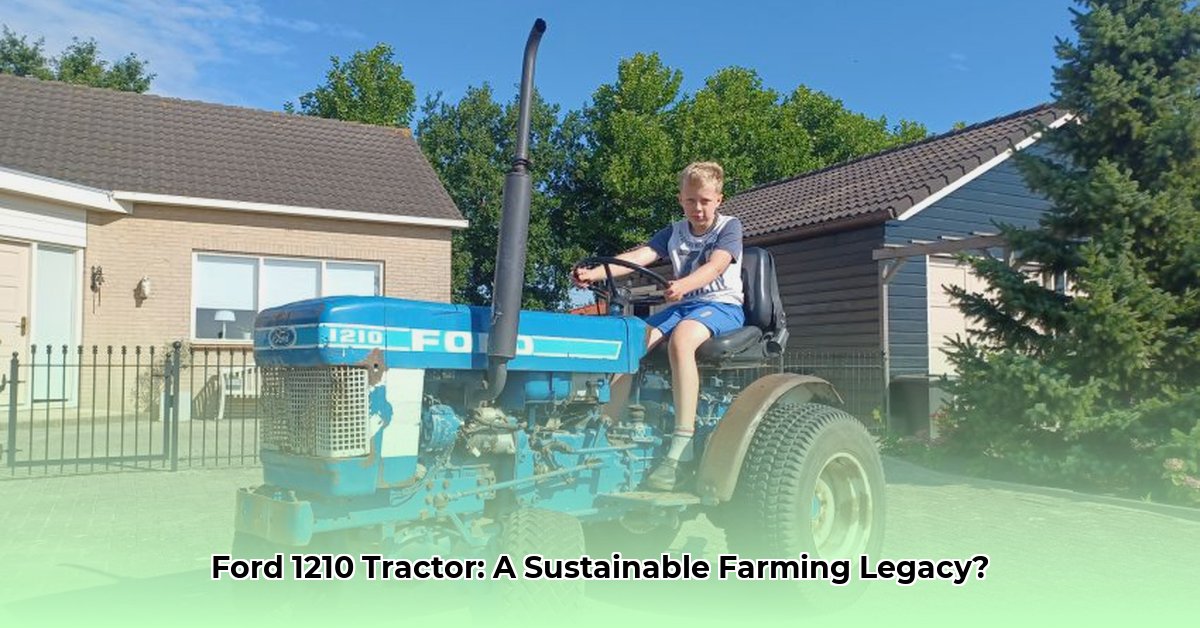
1210 Ford Tractor Specs: A Look Back at Sustainable Farming's Past
The Ford 1210 tractor, manufactured between 1983 and 1986, may not be a powerhouse in the modern farming landscape, but its design offers valuable insights into the early days of sustainable agriculture. This often-overlooked machine embodies a philosophy of efficient resource use and careful land management that resonates even today. We'll delve into its specifications, operational context, and its surprising relevance to contemporary sustainable farming practices. For more Ford tractor specs, check out Ford Tractor Specs.
The 1210: Small Size, Big Impact
At the heart of the 1210 was a Shibaura-built diesel engine, generating a modest 16 horsepower. Now, this wasn't the brute force of modern tractors; it was carefully chosen for its efficiency. This smaller engine reduced fuel consumption, minimizing the tractor's environmental impact. But how did this impact the farmer's bottom line? Lower fuel costs were a direct benefit, aligning perfectly with the growing focus on sustainable cost management.
Adaptability: The 1210's Secret Weapon
The 1210's remarkable versatility stemmed from its optional mid-PTO (power take-off), a feature that significantly enhanced its potential. This allowed farmers to easily attach a wide range of implements, from mowers and snow blowers to other specialized tools, all without needing separate equipment. This reduced the overall investment for small scale farms, while also streamlining operations and reducing fuel consumption. How did this impact the environmental consideration of sustainable agriculture? Less fuel consumption meant a smaller carbon footprint.
The 1210 in the Context of Sustainable Farming
While not explicitly designed for modern sustainability standards, the 1210's characteristics align remarkably well with the emerging awareness of environmental stewardship in the 1980s. Its compact size minimized soil compaction, a critical factor in maintaining long-term soil health and preventing erosion. What impact was less soil compaction? Healthier soil leads to better crop yields and reduced environmental damage. What is the overall environmental effect of its versatile design? It also resulted in lower fuel consumption and reduced emissions.
A Trip Down Memory Lane: The 1210's Legacy
The 1210 embodies the pragmatic technology and priorities of its time, prioritizing efficiency over sheer power. It showcases a resource-conscious approach that has lasting relevance. But how does it compare to today’s farming equipment? While modern tractors boast far greater power and advanced features like GPS guidance, they often come with increased size, cost, and potential for greater soil compaction. This raises an interesting question: did the trade-off between higher power and maneuverability truly benefit sustainable practices? The 1210 suggests a different perspective.
Key 1210 Ford Tractor Specs: A Quick Overview
| Specification | Value | Notes |
|---|---|---|
| Engine | Shibaura Diesel | Precise model varied by year of manufacture |
| Horsepower | 16 hp | Rated power output |
| Transmission | Varied depending on Model | Manual Transmission |
| PTO | Available, mid-PTO option | Power Take-Off - for powering implements |
| Weight | ~1334 lbs (estimated) | Information varies by configuration |
| Attachments | Many available | Mowers, snow blowers, and other implements |
| Production Years | 1983-1986 | This reflects the estimated production span. |
This table provides a summary; further research into specific model variations is recommended for a complete picture. The 1210's story isn't merely a technical specification; it's a testament to resource-conscious farming practices.
How did the Ford 1210 tractor's design impact its sustainability in 1980s agriculture?
The Ford 1210's compact size, efficient engine, and versatility inadvertently made it a pioneer of sustainable agricultural practices. It highlights a balance between power and efficiency that remains pertinent today.
Power and Efficiency: A Balancing Act
The 1210's 16 horsepower output, while modest, led to reduced fuel consumption, directly lowering operating costs and minimizing its carbon footprint. This efficiency was a significant contributor to its sustainability. How did it effect overall carbon footprint? By reducing fuel usage.
Compact Design: Less Impact, More Maneuverability
Its compact size and light weight minimized soil compaction, preserving soil structure and reducing erosion. This is particularly important for long-term soil health. What are the direct benefits to the soil? Healthier soil, better crop yields, and less environmental damage.
Versatility Through Attachments: Maximizing Resource Use
The 1210's ability to utilize a variety of implements reduced the need for multiple specialized machines, promoting both cost savings and efficient resource use. How did the overall resource utilisation effect the farm? It reduced both the financial and environmental burden.
Limitations and Considerations
While advantageous, the 1210's age raises concerns about parts availability and its capability to meet modern emission standards. However, this does not negate it's contribution to the early sustainable farming practices.
The 1210 in Context: A Sustainable Legacy?
Although not explicitly designed for sustainability, the Ford 1210's features aligned well with the principles of environmentally conscious farming that were emerging at the time. It exemplifies a considered approach to resource management, offering valuable lessons for modern agriculture.
Key Takeaways:
- Reduced fuel consumption minimizing the carbon footprint.
- Minimized soil compaction promoting soil health and reducing erosion.
- Versatility optimized resource use and minimized equipment investment.
- Parts availability and compliance with modern standards are limitations.
- The 1210 provides insight into effective, resource-conscious farming methods.
https://www.tractordata.com/farm-tractors/000/2/4/248-ford-1210.html